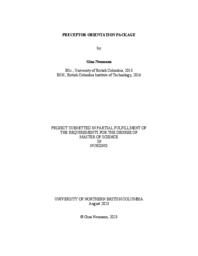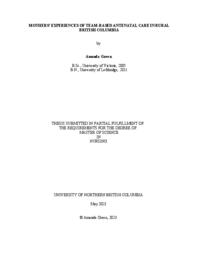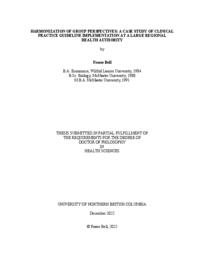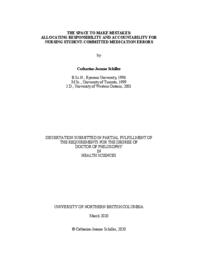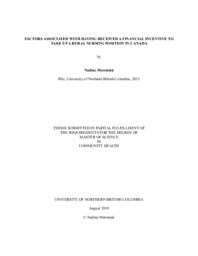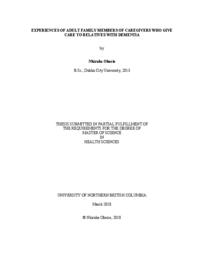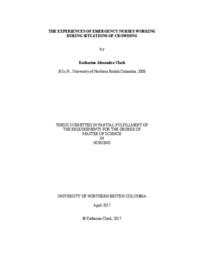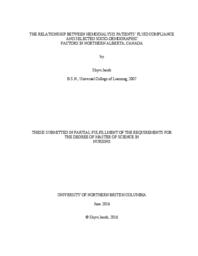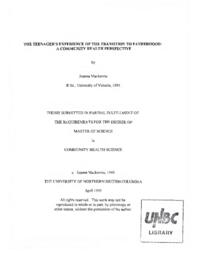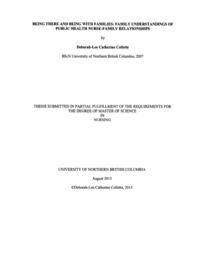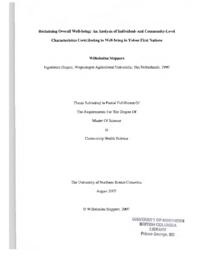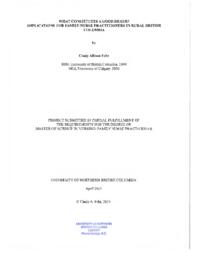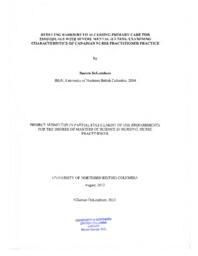MacLeod, Martha
Person Preferred Name
Martha MacLeod
Related Works
Content type
Digital Document
Description / Synopsis
The purpose of this project was to create an evidence-informed preceptor orientation package that would help nursing preceptors understand the essential components necessary to prepare for the preceptor role of BSN students in their final practicum in Level 3 Small Community Hospitals (21-100 beds) within the Interior Health Authority (IHA) in British Columbia. It was done in collaboration with IHA to fill a gap in preceptor education for registered nurses working with final practicum BSN students. A literature review identified key evidence-based nursing preceptor education concepts, which were integrated into a preceptor orientation package. The preceptor orientation package includes learning objectives and resources related to the role and responsibilities of the preceptor, goal-oriented preceptorship and learning styles, guiding a reflective discussion and feedback, creating a safe and supportive learning environment, and the preceptor’s motivation. The package's evaluation and implementation are explored, and the author's critical reflection concludes the paper.
Origin Information
Content type
Digital Document
Description / Synopsis
Introduction: The health care system in British Columbia places priority on providing teambased primary maternity care. Participation of mothers in planning their care is an essential component of team-based care. Therefore, it is important to understand mothers’ experiences of team-based maternity care. Background: An integrated literature review resulted in 12 articles focused on mothers’ experiences with antenatal care delivered by a team of providers. Evidence highlighted the positive impact of team-based speciality antenatal care. Mother’s experiences of community team-based antenatal care were a notable gap in the literature. Objective: To explore antenatal care experiences of mothers living in rural British Columbia, where team-based antenatal care is known to exist. Method: To understand the perceptions of mothers' experiences of team-based antenatal care a qualitative methodology was used. An interpretive description approach combined semi-structured interviews with eight mothers purposively selected from two rural communities. Findings: Mothers played a key role in shaping the continuity of their care. Mothers collaborated with their providers across three types of continuity expressed within a team-based antenatal care context: management, informational, and relational. Building the relationship between the mother and a consistent provider (relational continuity) required clinical coordination (management continuity) and clear communication (informational continuity). From the mother's perspective, a specific team composition did not rate as highly as the connection to a consistent provider with whom they had respectful and trusting relationship. For all eight mothers a nurse and physician team-combination promoted continuity and patient-centeredness. Specifically, a primary care maternity nurse role supported stability in the mother's antenatal care. Gaps in continuity arose from experiences of antenatal care during the Covid-19 global pandemic and in the mothers’ mental wellness and pelvic floor health. Conclusion: When the mothers shared responsibility for continuity in care this strengthened the mother-provider partnership, regardless of which discipline was providing care. Mothers appreciated the continuity of carer – a provider who could develop a relationship with them during their antenatal care. The mothers valued providers who worked as part of a network, collaborating with a range of interdisciplinary providers to support the mothers’ antenatal care needs. Clinical Implications: There is merit in expanding discussions on the value a consistent provider working alongside mothers in rural team-based primary maternity care brings to mothers’ experiences of and engagement with antenatal care. Future research on how both continuity of care and continuity of a carer can support sustainable team-based antenatal care to improve outcomes is warranted in all community contexts.
Origin Information
Content type
Digital Document
Description / Synopsis
Policy makers, health industry leaders, clinicians and researchers struggle to understand how new evidence-based practices, including Clinical Practice Guidelines (CPGs), can be implemented more quickly and more consistently. This retrospective qualitative case study explored sepsis CPG implementation at a British Columbia Regional Health Authority (RHA) between 2011-2017 to understand how individuals and teams with various functions and decision-making purviews come together to implement a prioritized CPG in a large RHA. The study was informed by practice theory and designed to provide practical guidance as to how CPG implementation might be better supported. Interviews involved 38 participants reflecting three functional groups: academics, regional managers and support staff, and clinicians. Over 350 documents and implementation process and outcome data were analyzed. The CPG implementation process was dynamic, involving different activities and intensities of involvement of individuals from each of the three groups. The three groups each behaved in a manner consistent with what some practice theorists call a community of practice. Individuals from each community of practice (COP) had a different perspective about the implementation along five dimensions (focus and rationale, vision, priority, appropriate balance and application of power, and goals, strategies and actions to be taken). The different COPs undertook actions that were consistent with their own COP perspective but not sufficiently aligned to ensure adherence to the CPG. The result was a discordant, and unsuccessful implementation. CPG adherence was not achieved. The differences in perspectives among the three COPs were substantial and appeared to have been deeply rooted in the beliefs, functions, experiences, and day-to-day realities of each of these groups of participants. The discordance in the implementation resulted from an insularity of each COP from the others, brought about by inadequate engagement among participants; insufficient connections across COPs to support shared understanding and alignment of action. Without some intervention, differences in perspectives will prevail and discordance is the likely outcome of any complex CPG implementation. This dissertation proposes the novel concept of harmonization as a means of achieving more successful CPG implementation; a process intended to reduce insularity of individual COPs within and beyond a RHA. Harmonization is conceptualized as a process comprised of many harmonizing activities that support engagement, relationship-building and explicit reflection and reconciliation of key differences in perspective among the three COPs. As a relational process, harmonization is largely determined by longstanding, contextual factors that support connections and collaboration among COPs. Widely engaging, horizontal, service-oriented improvement structures (with clear supporting roles and processes) establish a foundation for harmonization. Ongoing local interprofessional learning and improvement activities are essential to ensuring that the service improvement benefits from strong clinical engagement. RHA managers, particularly clinical managers, can support harmonization by encouraging open sharing of perspectives and managing in a way that is responsive to the realistic ebbs and flows of the implementation process. Harmonization integrates and builds upon many known CPG implementation determinants and strategies to bring a practical focus for future research and action.
Origin Information
Content type
Digital Document
Description / Synopsis
A medication error committed by a student nurse during a clinical placement often results in the student fearing its potential impact on the patient, unit staff, and the student’s educational journey. Student nurses must navigate two parallel systems during a clinical placement – the educational system and the healthcare system – and there can be confusion about what each requires of the student. Neither of these systems contain clear direction for managing student-committed medication errors and for allocating associated responsibility and accountability. This exploratory mixed methods study examines the process by which responsibility and accountability for a student-committed medication error is allocated and the factors that influence that allocation decision. It describes key features of an ideal allocation process and suggests reasons why the current allocation process often does not meet those requirements. Qualitative data were analyzed through interpretive description and quantitative data were analyzed using descriptive statistics. The results were situated, interpreted, and triangulated within a critical realism philosophical framework. An ideal post-error environment must incorporate a just culture. Since students must navigate both the educational institution and the healthcare facility environments during a clinical placement, a just culture must permeate both. However, students are instead colliding with a post-error environment that they perceive as not meeting key ideals of a just culture: fairness, transparency, minimization of fear, and dedication to learning. Findings of this study can be used to drive change that will better support those who are involved in a post-error process, and decrease the significant inconsistencies that are currently of particular concern.
Origin Information
Content type
Digital Document
Description / Synopsis
In Canada, financial incentives are used to entice nurses to rural practice. While financial incentives are used throughout Canada, the characteristics of nurses who have received a financial incentive are seldom examined. The purpose of the study is to examine what factors are associated with having received a financial incentive to practice in rural and remote Canada. A pan-Canadian survey was distributed to nurses working in rural and remote Canada. The survey received a 40% response rate (n=3,822). Of the 3,822 eligible nurses who responded 12.6%(n=466) of nurses identified as having received a financial incentive to take up their rural nursing position. Chi-square and multiple logistic regression analyses found characteristics and other factors associated with having received a financial incentive to take up a rural nursing position. The study concludes that financial incentives continue to have implications for recruitment of nurses to practice in rural Canada.
Origin Information
Content type
Digital Document
Origin Information
Content type
Digital Document
Origin Information
Content type
Digital Document
Origin Information
Content type
Digital Document
Origin Information
Content type
Digital Document
Origin Information
Content type
Digital Document
Origin Information
Content type
Digital Document
Origin Information
Content type
Digital Document
Origin Information
Content type
Digital Document
Origin Information
Content type
Digital Document
Origin Information
Content type
Digital Document
Origin Information
Content type
Digital Document
Origin Information
Content type
Digital Document
Origin Information
Content type
Digital Document
Origin Information
Content type
Digital Document
Origin Information
Content type
Digital Document
Origin Information
Content type
Digital Document
Origin Information
Content type
Digital Document
Origin Information
Content type
Digital Document
Origin Information
Content type
Digital Document
Origin Information

